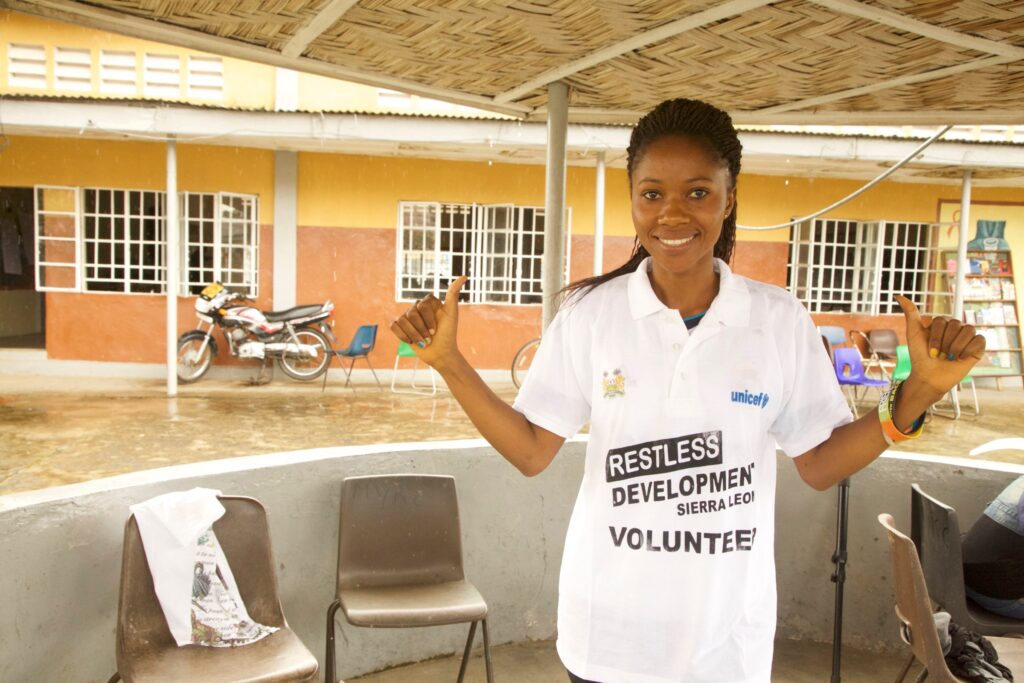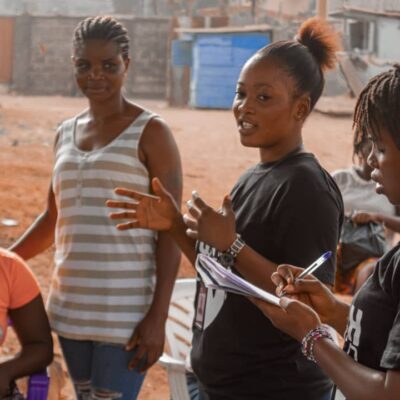When Crisis hit, young people responded
In March 2014 Sierra Leone was hit by the largest ever outbreak of the Ebola Virus Disease (EVD) in history. Young people responded with the largest community mobilisation in Sierra Leone’s history. Almost 2,500 young volunteers from the hastily assembled Social Mobilisation Action Consortium (SMAC) (formed by GOAL, Restless Development, Focus 1000, and BBC Media Action), reached over 3 million people with life saving interventions.
Socio-cultural factors contributed significantly to the spread of Ebola. Lack of knowledge, fear and stigma prevented understanding and dissuaded crucial behaviour changes.
- Lack of prior knowledge of EVD and lack of trust in authorities led communities to deny its existence and/or to link it with witchcraft or believe conspiracy theories.
- The stigma of EVD survivors and victims’ families increased infection rates. For example, some families were found to be hiding relatives and friends with EVD to avoid being shunned by their communities. Isolation periods due to possible infection were thought of as death sentences. The sick were often being kept at home and buried in secret – increasing the risk of more infections.
- The cultural tradition of washing and touching bodies before burial greatly increased infection rates, and funerals transmitted the infection to wider families and other areas.
The Community-Led Ebola Action (CLEA) approach engaged communities, empowering them to protect themselves quickly and efficiently with their own resources.
I have seen many young people taking the lead to fight against Ebola, and I want to be a part of that team, so tomorrow I will be able to put up my hand and say ‘yes I have shown love and loyalty to my country, Sierra Leone.
Alhaji, 22, mobiliser

How did mobilisers interact with communities?
- Body mapping – the community maps the parts of the body which suffer when infected with EVD;
- Burial roleplay – the community recreates a burial situation where risks (i.e. cleaning the corpse) are identified, and alternative actions are brought forward;
- Ebola spread – the ways of EVD transmission are highlighted by the community;
- Danger discussion – a discussion around the dangers of sickness and death is triggered for the community to raise awareness and suggest action points for them to take;
- Survivor roleplay – some communities host EVD survivors and some mobilisers were EVD survivors. Communities need to understand that survivors don’t represent a risk, and that they are an asset to them as they have been proved immune to re-contracting EVD;
- Personal Protective Equipment (PPE) information – communities feared PPE, jeopardising the work of medical workers. For many communities, PPE was strange and scary, and they didn’t understand the purpose of it or that a person was inside.

Biggest successes
Communities welcomed the mobilisers; having experienced EVD in their communities they were ready for external support and were keen to know more about how to stay safe. There was a lot of distrust towards institutions leading the response as people who were thought to have contracted EVD were taken to response centres and often never returned to their communities. This was due to high death rates and an overwhelmed medical care system. This created and exasperated suspicion and fear in communities about the response and those leading it. The mobilisers’ biggest achievement was building trust in the institutions leading the response.
Restless Development harnessed the energy and power of young people to address EVD in a culturally appropriate way, where communities were at the centre of the action.
It is clear that the nature and timing of the interventions delivered under this project are likely to have contributed significantly to preventing new infections and the associated reduction in transmission of the disease.
Report from UK Aid
What happened next?
After the EVD outbreak had ended, Restless Development worked with young Sierra Leoneans who had played key roles in the response efforts to understand how they wanted to be involved in the development of their country going forward.
From this, we designed and delivered a programme with young Sierra Leoneans that addressed challenges with public services across the country.
Documents about our Ebola response
Community-Led Ebola Action (CLEA) Field Guide
This Field Guide was created for Community Mobilisers and others working on SMAC and the wider EVD response in Sierra Leone, as well as others looking to implement the approach. PDF / 3.50 MB
PDF / 3.50 MB
Restless Development Ebola Response Mid-Term Review
A review of our response to the EVD outbreak from 2014-15, highlighting best practices, innovations, challenges and solutions. PDF / 924.60 KB
PDF / 924.60 KB
Read our parliamentary submission on the EVD outbreak
Our submission to the Africa APPG inquiry: Call for written evidence on community led health systems & the Ebola outbreak – Submission on 24th June 2015. PDF / 702.95 KB
PDF / 702.95 KB




